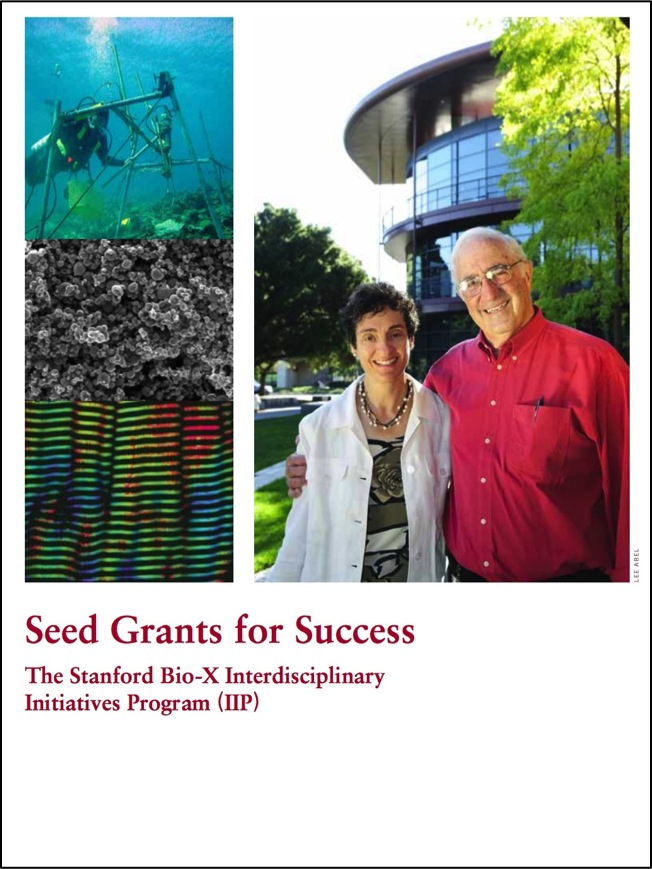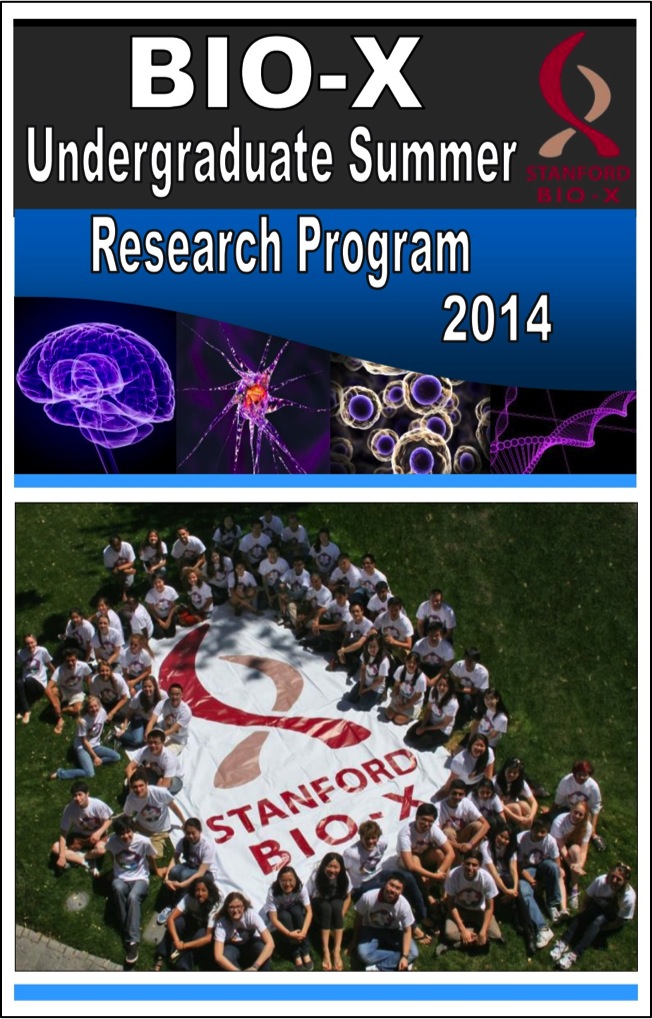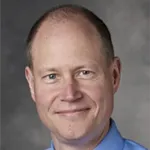
Welcome to the biweekly electronic newsletter from Stanford Bio-X for members of the Bio-X Corporate Forum. Please contact Dr. Hanwei Li, the Bio-X Corporate Forum Liaison if you would like to be added or removed from this distribution list, or if you have any questions about Stanford Bio-X or Stanford University.
Highlights
** On October 9, 2013, Bio-X celebrated the 10th Anniversary of the James H. Clark Center, the hub of Bio-X. Check out CLARK CENTER @ 10X as well as the Bio-X Timeline over the last 15 years!!
** Check out the article by Stanford President John Hennessy in the Nov/Dec 2013 issue of the Stanford Magazine on Bio-X and the Clark Center, "A Cauldron of Innovation".
Bio-X Core Programs
 SEED GRANTS FOR SUCCESS - Stanford Bio-X Interdisciplinary Initiatives Program (IIP) SEED GRANTS FOR SUCCESS - Stanford Bio-X Interdisciplinary Initiatives Program (IIP)The Bio-X Interdisciplinary Initiatives Program represents a key Stanford Initiative to address challenges in human health. Currently, the IIP awards approximately $4 million every other year in the form of two-year grants averaging about $200,000 each. From its inception in 2000 through the beginning of the seventh round in 2014, the program has provided critical early-stage funding to 164 different interdisciplinary projects, involving collaborations from over 750 faculty members, and creating over 700 teams from six different Stanford schools. From just the first 6 rounds, the IIP awards have resulted in a 10-fold-plus return on investment, as well as hundreds of publications, dozens of patents filed, and most importantly, the acceleration of scientific discovery and innovation. 2014 is the start of the 7th round of the Bio-X IIP Seed Grants Program, and 22 newly awarded projects were selected from 142 Letters of Intent (LOIs)! This has been the largest number of LOIs that Bio-X has received. Please go here to check out the newly awarded projects. Competition was intense, and the selection criteria included innovation, high-reward, and new interdisciplinary collaborations. (To view the 142 other IIP projects that have been funded from the previous 6 rounds, please click here.) |
 Bio-X FELLOWSHIPS Bio-X FELLOWSHIPSEvery year, graduate students and postdoctoral scholars of Bio-X affiliated faculty are highly encouraged to apply for the Bio-X Fellowships, which are awarded to research projects that are interdisciplinary and utilize the technologies of different fields to solve different biological questions. Students are encouraged to work collaboratively with professors of different departments, thus creating cross-disciplinary relationships among the different Stanford schools. Our fellows have conducted exciting research, resulting in publications in high-impact journals and have been offered excellent positions in industry and academia. To date, with the 19 new awardees of 2014, Stanford Bio-X has a total of 173 Fellows. The winners of the 2015 PhD Fellowship program will be announced later on this year. You can view the numerous Fellowship projects that have been awarded over the years as well as oral presentations from previous symposiums here. |
 Bio-X UNDERGRADUATE SUMMER RESEARCH PROGRAM Bio-X UNDERGRADUATE SUMMER RESEARCH PROGRAMThe Bio-X Undergraduate Summer Research Program (USRP) supports undergraduate research training through an award designed to support interdisciplinary undergraduate summer research projects. The program is an invaluable opportunity for students to conduct hands-on research, learn how to carry out experiments in the laboratory, and develop the skills to read and analyze scientific literature. This program is eligible to Stanford students who want to work in the labs of Bio-X affiliated faculty. This year, nearly 160 students applied to the program, and 65 students were selected. Therefore, to date, 371 awards have been given to the Stanford undergraduate community to participate in the Bio-X Summer Research Program. The program for 2015 officially started last week. In addition, the Bio-X USRP Faculty Talks have begun, and take place every Wednesday from 12-1 pm until August 26, 2015. Please email Hanwei Li to learn more details and RSVP for any of the faculty talks. Participating undergraduates are also required to present poster presentations on the research that they've conducted during the program. The 2015 posters will be presented during the next Bio-X IIP Seed Grant Symposium on Wednesday, August 26, 2015. Please click here for title lists of past posters that our undergraduates have presented. |
We are cultivating and are highly successful in building meaningful collaborations with numerous corporate colleagues. New collaborations through our core programs are highly encouraged. To learn about how to get involved, please contact Dr. Hanwei Li, or Dr. Heideh Fattaey.
Bio-X also holds symposiums every year that highlight our core programs. The latest one was on February 25, 2015, where over 300 people attended Bio-X's latest Interdisciplinary Initiatives Seed Grants Program Symposium. There were 8 different oral presentations from faculty members who were awarded Bio-X Seed Grants on the progress that they have made with the funding towards their projects, as well as a packed poster session with 100+ research projects presented. Please stay tuned for future Bio-X symposiums that are coming up this year!
If you'd like to learn more about any of the projects that were presented during the entire symposium, please contact Dr. Hanwei Li with your questions.
News
 BUILDING A BRAIN
BUILDING A BRAIN
Bio-X Affiliated Faculty Karl Deisseroth, Brian Wandell, Michael Lin, Mark Schnitzer, Amit Etkin, Surya Ganguli, Krishna Shenoy, Kwabena Boahen, Fei-Fei Lin
Computers will one day match our own mental agility; learning, navigating and performing complex interactions all on scant power. But getting to that point will require neuroscientists and engineers to reverse engineer our least understood organ—the brain.

 Research sheds light on how neurons control muscle movement
Research sheds light on how neurons control muscle movement
Bio-X Affiliated Faculty Krishna Shenoy and Jaimie Henderson
A Stanford Bio-X NeuroVentures supported project
Stanford University researchers studying how the brain controls movement in people with paralysis, related to their diagnosis of Lou Gehrig’s disease, have found that groups of neurons work together, firing in complex rhythms to signal muscles about when and where to move. “We hope to apply these findings to create prosthetic devices, such as robotic arms, that better understand and respond to a person’s thoughts,” said Jaimie Henderson, MD, professor of neurosurgery. A paper describing the study was published online June 23 in eLife. Henderson, who holds the John and Jene Blume-Robert and Ruth Halperin Professorship, and Krishna Shenoy, PhD, professor of electrical engineering and a Howard Hughes Medical Institute investigator, share senior authorship of the paper. The lead author is postdoctoral scholar Chethan Pandarinath, PhD. The study builds on groundbreaking Stanford animal research that fundamentally has changed how scientists think about how motor cortical neurons work to control movements. “The earlier research with animals showed that many of the firing patterns that seem so confusing when we look at individual neurons become clear when we look at large groups of neurons together as a dynamical system,” Pandarinath said.
 Molecular cause of heart condition identified by researchers
Molecular cause of heart condition identified by researchers
Bio-X Affiliated Faculty Joseph Wu
In 2012, researchers at the Stanford University School of Medicine showed that heart muscle cells made from the skin of people with a cardiac condition called dilated cardiomyopathy beat with less force than those made from the skin of healthy people. These cells also responded less readily to the waves of calcium that control the timing and strength of each contraction. Now, the same research team has teased apart the molecular basis for these differences and identified a drug treatment that at least partially restores function to diseased cells grown in a laboratory dish. They also observed how a key cardiac signaling cascade, called the beta-adrenergic pathway, develops as heart muscle cells mature, and identified key aspects about how it functions in both normal and diseased cells. The researchers hope that the findings will help clinicians better hone treatments for a variety of cardiac conditions, which are now often treated with a one-size-fits-all approach. “Right now, nearly all patients with cardiomyopathy are given drugs to modulate the beta-adrenergic pathway in the heart, which is known to be dysfunctional,” said Joseph Wu, MD, PhD, director of Stanford’s Cardiovascular Institute. “But until now, we’ve not known what exactly is going wrong with this pathway at a molecular level.” A paper describing the research was published online June 18 in Cell Stem Cell. Wu, a professor of medicine and of radiology, is the senior author of the paper, and postdoctoral scholar Haodi Wu, PhD, is the lead author. (Joseph Wu and Haodi Wu are not related.)
 Brain connections last as long as the memories they store, Stanford neuroscientist finds
Brain connections last as long as the memories they store, Stanford neuroscientist finds
Bio-X Affiliated Faculty Mark Schnitzer
Our memories are as fleeting as the brain structures that store them, or so the theory goes. When the connections – called synapses – between neurons break, the memories they hold are thought to evaporate along with them. The idea seemed good, but has been hard to test. Now a Stanford team has taken on the challenge, studying a brain region called the hippocampus, which stores "episodic" memories. These are the memories of events or conversations that might be forgotten over time if the memories aren't used. The challenge to studying synapses in this region is that the hippocampus is so deep and the connections so densely packed that no microscope could easily monitor the synapses' longevity. Now Mark Schnitzer, an associate professor of biology and of applied physics, has leveraged microscopy tools developed in his lab and for the first time was able to monitor the connections, called synapses, between hippocampal neurons and confirm what neuroscientists thought might be happening. In the mice he and his team studied, the connections between neurons lasted about 30 days, roughly the duration over which episodic memories are believed to stay in the mouse hippocampus. The work was published on June 22 in Nature.
 Single-catalyst water splitter from Stanford produces clean-burning hydrogen 24/7
Single-catalyst water splitter from Stanford produces clean-burning hydrogen 24/7
Bio-X Affiliated Faculty Yi Cui
Stanford University scientists have invented a low-cost water splitter that uses a single catalyst to produce both hydrogen and oxygen gas 24 hours a day, seven days a week. The device, described in a study published June 23 in Nature Communications, could provide a renewable source of clean-burning hydrogen fuel for transportation and industry. "We have developed a low-voltage, single-catalyst water splitter that continuously generates hydrogen and oxygen for more than 200 hours, an exciting world-record performance," said study co-author Yi Cui, an associate professor of materials science and engineering at Stanford and of photon science at the SLAC National Accelerator Laboratory. In an engineering first, Cui and his colleagues used lithium-ion battery technology to create one low-cost catalyst that is capable of driving the entire water-splitting reaction. "Our group has pioneered the idea of using lithium-ion batteries to search for catalysts," Cui said. "Our hope is that this technique will lead to the discovery of new catalysts for other reactions beyond water splitting."
Events
| Events |
| Pathology July 14, 2015, 12:30 pm - 1:30 pm LKSC Rm 130, Stanford, CA “Next Generation” Immunohistochemistry in the Diagnosis of Soft Tissue Tumors Speaker: Jason L. Hornick, MD, PhD, Brigham and Women’s Hospital |
Bio-X July 16, 2015, 12 pm - 1 pm Clark Center Auditorium, Stanford, CA Stanford Bio-X Seminar:"How Experience Changes Synapses in the Mammalian Brain" Speaker: Tobias Bonhoeffer, PhD, Stanford, Max Planck Institute, University in Munich |
Resources
| Stanford University |
| Stanford Bio-X |
| Bio-X Seed Grants The Stanford Bio-X Interdisciplinary Initiatives Program (IIP) provides seed funding for high-risk, high-reward, collaborative projects across the university, and have been highly successful in fostering transformative research. |
| Office of Technology and Licensing "Techfinder" Search the OTL Technology Portal to find technologies available for licensing from Stanford. |
| Stanford Center for Professional Development - Take advantage of your FREE membership! - Take online graduate courses in engineering, leadership and management, bioscience, and more. - Register for free webinars and seminars, and gets discounts on courses. |
| Stanford Biodesign Video Tutorials on how FDA approves medical devices A series of video briefs recently produced by the Stanford Biodesign Program teaches innovators how to get a medical device approved for use in the United States. This free, online library of 60 videos provides detailed information on the Food and Drug Administration regulatory process, short case studies and advice on interacting with the FDA. |
To learn more about Stanford Bio-X or Stanford University, please contact Dr. Hanwei Li, the Bio-X Corporate Forum Liaison, at 650-725-1523 or lhanwei1@stanford.edu, or Dr. Heideh Fattaey, the Executive Director of Bio-X Operations and Programs, at 650-799-1608 or hfattaey@stanford.edu.

